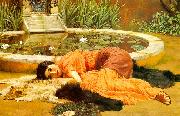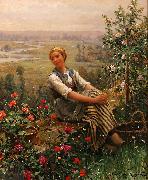
Oil On
Canvas, Real Flavor of Old Masters
|
John William Godward
|
|||
|
|
|||
| English 1861-1922 Godward was a Victorian Neo-classicist, and therefore a follower in theory of Frederic Leighton. However, he is more closely allied stylistically to Sir Lawrence Alma-Tadema, with whom he shared a penchant for the rendering of Classical architecture, in particular, static landscape features constructed from marble. The vast majority of Godward's extant images feature women in Classical dress, posed against these landscape features, though there are some semi-nude and fully nude figures included in his oeuvre (a notable example being In The Tepidarium (1913), a title shared with a controversial Alma-Tadema painting of the same subject that resides in the Lady Lever Art Gallery). The titles reflect Godward's source of inspiration: Classical civilisation, most notably that of Ancient Rome (again a subject binding Godward closely to Alma-Tadema artistically), though Ancient Greece sometimes features, thus providing artistic ties, albeit of a more limited extent, with Leighton. Given that Classical scholarship was more widespread among the potential audience for his paintings during his lifetime than in the present day, meticulous research of detail was important in order to attain a standing as an artist in this genre. Alma-Tadema was, as well as a painter, an archaeologist who attended historical sites and collected artefacts that were later used in his paintings: Godward, too, studied such details as architecture and dress, in order to ensure that his works bore the stamp of authenticity. In addition, Godward painstakingly and meticulously rendered those other important features in his paintings, animal skins (the paintings Noon Day Rest (1910) and A Cool Retreat (1910) contain superb examples of such rendition) and wild flowers (Nerissa (1906), illustrated above, and Summer Flowers (1903) are again excellent examples of this). The appearance of beautiful women in studied poses in so many of Godward's canvases causes many newcomers to his works to categorise him mistakenly as being Pre-Raphaelite, particularly as his palette is often a vibrantly colourful one. However, the choice of subject matter (ancient civilisation versus, for example, Arthurian legend) is more properly that of the Victorian Neoclassicist: however, it is appropriate to comment that in common with numerous painters contemporary with him, Godward was a 'High Victorian Dreamer', producing beautiful images of a world which, it must be said, was idealised and romanticised, and which in the case of both Godward and Alma-Tadema came to be criticised as a world-view of 'Victorians in togas'. | |||
|
|
|||
|
|
Dolce Far Niente John William Godward3.jpg Painting ID:: 1800 Visit European Gallery |
1904 | |
Height Width |
INS/CM |
||
|
X |
|
||
|
|
|||
|
John William Waterhouse
|
|||
|
|
|||
| English Pre-Raphaelite Painter, 1849-1917 English painter. His father was a minor English painter working in Rome. Waterhouse entered the Royal Academy Schools in London in 1870. He exhibited at the Society of British Artists from 1872 and at the Royal Academy from 1874. From 1877 to the 1880s he regularly travelled abroad, particularly to Italy. In the early 1870s he had produced a few uncharacteristic Orientalist keepsake paintings, but most of his works in this period are scenes from ancient history or classical genre subjects, similar to the work of Lawrence Alma-Tadema (e.g. Consulting the Oracle, c. 1882; London, Tate). However, Waterhouse consistently painted on a larger scale than Alma-Tadema. His brushwork is bolder, his sunlight casts harsher shadows and his history paintings are more dramatic. | |||
|
|
|||
|
|
Dolce Far Niente new3/John William Waterhouse-224943.jpg Painting ID:: 27654 Visit European Gallery |
mk58 1880 oil on canvas 50x95.5cm Kirkcaldy Museum and Art Gallery,Scotland | |
Height Width |
INS/CM |
||
|
X |
|
||
|
|
|||
|
Daniel Ridgeway Knight
|
|||
|
|
|||
| 1839-1924 Daniel Ridgeway Knight Gallery Daniel Ridgway Knight was born on March 15,1839 in Pennsylvania. He studied and exhibited at the Pennsylvania Academy of the Fine Arts, were he was a classmate of Mary Cassatt and Thomas Eakins. In 1861, he went to Paris to study at L'Ecole des Beaux-Arts under Cabanel, and to apprentice in the atelier of Charles-Gabriel-Gleyere. | |||
|
|
|||
|
|
Dolce Far Niente new20/Daniel Ridgeway Knight-342974.jpg Painting ID:: 57528 Visit European Gallery |
oil on canvas | |
Height Width |
INS/CM |
||
|
X |
|
||
|
|
|||
|
John William Waterhouse
|
|||
|
|
|||
| English Pre-Raphaelite Painter, 1849-1917 English painter. His father was a minor English painter working in Rome. Waterhouse entered the Royal Academy Schools in London in 1870. He exhibited at the Society of British Artists from 1872 and at the Royal Academy from 1874. From 1877 to the 1880s he regularly travelled abroad, particularly to Italy. In the early 1870s he had produced a few uncharacteristic Orientalist keepsake paintings, but most of his works in this period are scenes from ancient history or classical genre subjects, similar to the work of Lawrence Alma-Tadema (e.g. Consulting the Oracle, c. 1882; London, Tate). However, Waterhouse consistently painted on a larger scale than Alma-Tadema. His brushwork is bolder, his sunlight casts harsher shadows and his history paintings are more dramatic. | |||
|
|
|||
|
|
Dolce far Niente new21/John William Waterhouse-322632.jpg Painting ID:: 61549 Visit European Gallery |
Dolce far Niente 1880 | |
Height Width |
INS/CM |
||
|
X |
|
||
|
|
|||










